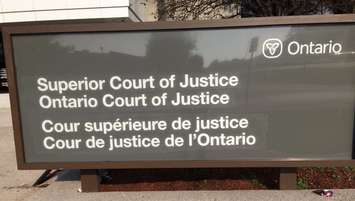A Chatham-Kent Ontario Provincial Police (CK OPP) officer on trial for manslaughter will learn his fate next month.
OPP Constable Sean O'Rourke, 58, is charged in the fatal shooting of 24-year-old Nicholas Grieves on Highway 401 near Ridgetown on July 7, 2021 following a gas theft.
The prosecution and defence made their closing submissions in Chatham Superior Court on Friday.
Crown Attorney Jason Nicol argued there was no reason for O'Rourke to fire his gun, saying the officer exaggerated the risks he was facing that night to justify drawing his gun.
Nicol called firing the gun "a dangerous and unlawful act" and noted that O'Rourke shouldn't have had his finger on the trigger, questioning why there was no call for backup.
He called O'Rourke's account of a stumble that propelled him partly inside the car "fabricated," adding that pointing the gun was an overreaction.
O'Rourke previously testified that he stumbled into the car and may have discharged his gun unintentionally with a clutch reflex when he tried to back out.
"The stumble theory is just a convenient explanation by the accused designed to make it seem like the discharge was unforeseen and completely beyond his control," Nicol said.
Nicol also told the court that everything happened so fast that the suspects didn't have time to react to surrender commands issued by O'Rourke.
He also questioned how O'Rourke could have seen Grieves' "crazed eyes" when Grieves was inside the car when O'Rourke approached with his gun already drawn.
"How he was able to see such a minute detail from his position 10-12 metres behind the car on a very dark highway lacks credibility to say the least," said Nicol.
He added the people inside the car didn't make any threatening gestures, say anything threatening, or brandished any weapons, adding that O'Rourke couldn't have been shooting to stop the car because under Canadian law, officers can't shoot to stop fleeing cars.
Nicol also accused O'Rourke of having a convenient memory.
"It defies common sense that he cannot recall the most important issue in this trial and that is how his gun fired," said Nicol. "This memory gap is a transparent attempt to avoid the obvious and that is, he fired the gun and he knows it."
Nicol said his theory is that O'Rourke knows his finger slid off the trigger guard and pulled the trigger and he's not admitting or his finger was on the trigger the whole time, adding there were no reasonable grounds to protect against death or serious bodily harm.
Defence lawyer Sandy Khehra disagreed, saying that a police firearms and training expert testified that drawing the gun was justified under dangerous circumstances.
He also noted that people forget things when they're under stress.
Khehra also disagreed the gun's muzzle should have been pointed down and not at Grieves, adding that it made no sense because O'Rourke was using his gun light to try and see what was in the car and where Grieves' hands were.
He also told the court there's no doubt that O'Rourke stumbled and the evidence proves it.
The judge had many questions during the closing submissions.
Justice Bruce Thomas wondered why there was no de-escalation attempt before the gun was drawn, asking "what's the rush" because the suspect's car was stuck in the mud and not going anywhere.
Thomas also pointed out that OPP Sergeant Bradley Cook, who arrived shortly after O'Rourke, didn't draw his gun.
Calling it "ridiculous", Thomas also questioned why there was no accident reconstruction because O'Rourke previously testified that Grieves rammed his unmarked cruiser while trying to flee.
Justice Thomas will render his decision on June 24, 2025 at 2 p.m.






